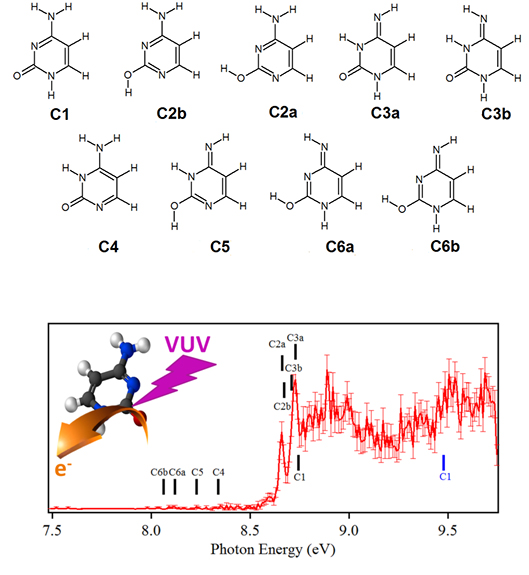The study of biological macromolecules, such as DNA, RNA and proteins requires a prior and thorough knowledge of the physicochemical properties of their constitutive bricks, namely nucleobases and amino acids, respectively. Experimentally, several species (isomers and tautomers) coexist, making it very difficult to interpret and deduce the properties of the biologically important molecules they constitute. A large international scientific consortium, organized around the University of Paris-Est Marne-La-Vallée and including the CEA-Paris-Saclay University and SOLEIL, was able to identify the tautomers and isomers of the cytosine cation in the gas phase, using the most sophisticated quantum chemistry methods associated with VUV photoionization by photoelectron imaging implemented on the DESIRS beamline.
Those results have been published in the Journal of the American Chemical Society.
The study of ionized DNA or RNA species has become increasingly important in recent decades because damage caused by the interaction between ionizing radiation and biological material can lead to genetic material mutations, inducing cancers. Conversely, in medicine, biological material is irradiated in order to cause such damages and destroy cancer cells. The understanding of the phenomena involved by the irradiation of the genetic material (DNA and RNA) at the molecular level participates in the development of treatments. However, the intrinsic properties of the DNA and RNA elementary bricks are not all well known. The chemical reactivity induced by the irradiation is still under study and also requires the precise determination of the thermo-chemical and structural data for the neutral and ionized nucleic bases. These biological entities present a varied set of forms - isomers and tautomers - whose ionization spectra must be studied to understand their behavior in presence of ionizing radiations.
The difficulty of interpreting the measurements lies in the complexity of the electronic structure of these species and in the coexistence of several closely related conformers / tautomers / isomers.
In this work, scientists have combined the use of new ab initio methods explicitly correlated that have just been implemented in the computational codes, and the VUV synchrotron radiation of the DESIRS beamline equipped with a double imaging electron-ion coincidence spectrometer (i2PEPICO). Thus, it was possible to determine the adiabatic ionization energies of the cytosine tautomers and isomers isolated in the gas phase, for the first time with an accuracy of 0.003 eV. The experimental spectra correspond to well-resolved bands that could be attributed to the specific contribution of five cytosine tautomers / isomers in the medium studied (see Figure 1).

Figure 1: Structures of tautomers / cytosine isomers and their identification in the spectrum of slow photoelectrons ejected after VUV photoionization. © M. Hochlaf.
